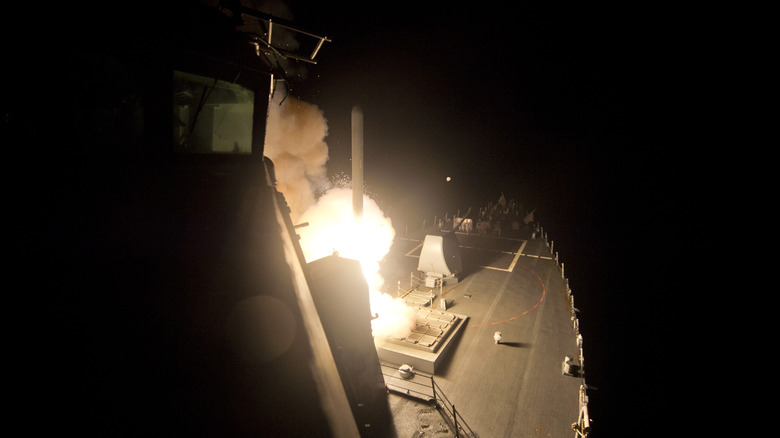The Modern Warship Missile System You Don't Want To Reload
The VLS — or Vertical Launch System — found on U.S. Navy destroyers and other warships is remarkably complex and delicate, requiring precision during launch and reloading. Currently, the Navy requires reloading of the missile tubes on its warships to be done at an approved pier. As such, the only suitable locations for this process for its Pacific Fleet are in Japan, Guam, Hawaii, and California, meaning a ship that has launched all its missiles could be out of commission for weeks in order to travel back and forth to be reloaded.
The Navy is currently experimenting with ways to reload its destroyers at sea, and last fall it tested the process in San Diego Harbor by using the experimentation ship MV Ocean Valor to load the destroyer USS Spruance. Some work was done dockside with empty and weighted dummy canisters, but at-sea tests were scuttled because of rough waters. Third Fleet spokesman Cmdr. Sean Robertson told USNI News, "There was an open-ocean work scheduled. They did not do it. They had some safety concerns. Because of excessive roll, they didn't do the open-ocean transfer." Robertson stressed that the exercise did not involve any live ordnance, and said the Navy was evaluating reports and formulating plans for future testing.
At-sea VLS reloading is a top priority for the Navy
TThe Navy has been experimenting with at-sea VLS reloading since 2016 in San Diego and Seal Beach. Navy Secretary Carlos Del Toro considers the turnaround time for ships that have to return to base to reload to be a huge vulnerability and is making at-sea VLS reloading a top priority for the seafaring branch.
"Without question, logistics rises to the top in terms of priorities that are necessary — logistics in terms of the forward presence that we're going to need in the Indo-Pacific, to forward-deploy parts and supplies and troops and everything that we need, in addition to the capabilities that individual ships themselves will need in order to be able to rearm," Del Toro told Defense News.
Ships can currently be supplied with food, fuel, and other supplies while at sea, but transferring highly explosive munitions in choppy waters presents a weighty challenge for Del Toro and his charges.
Capt. Kendall Bridgewater, Commodore of Military Sealift Command Pacific, noted that the tests failed when rough seas made it impossible for operators to control the crane used to position the dummy missile canister. "Unfortunately, that [missile transfer] was not able to be done because we saw that we had excessive motion between the two ships" beyond the safety limits, Bridgewater said. "We had excessive swing with the crane, which did not allow us to accomplish the at-anchor portion."
